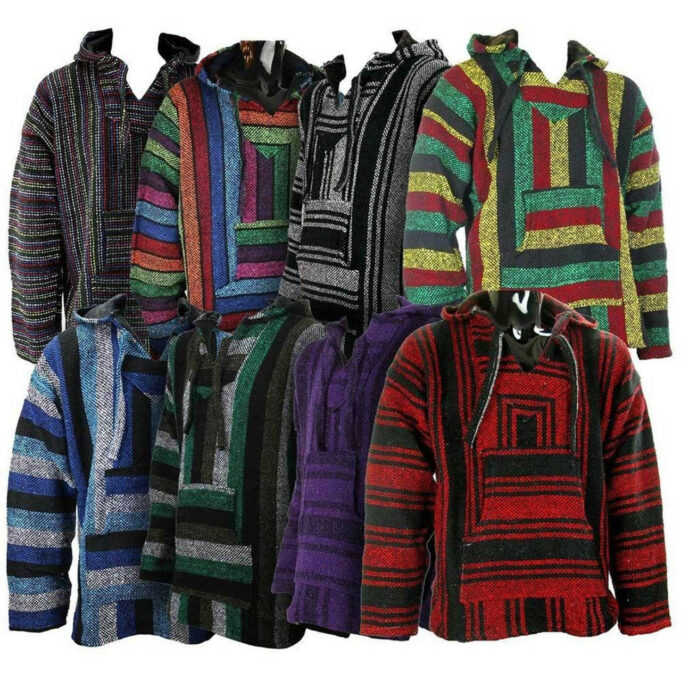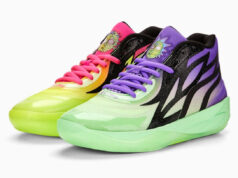Numerous individuals ponder the definition of a drug rug. Contrary to its name, a drug rug does not refer to a floor covering used for drug-related activities. Instead, it is a type of clothing article. Originally known as Baja hoodies and originating from Baja, Mexico, these garments gained popularity among California surfers in the 1970s. The term “drug rug” was later embraced due to the prevalent use of marijuana during that era and location.
In brief, drug rugs, also known as Baja hoodies, are hooded sweatshirts crafted from hemp or cotton blends. These garments have strong associations with marijuana use, which is why they earned the nickname “drug rug.”
Origin of the Drug Rug
The concept of the Baja hoodie originated in Baja, Mexico. Local inhabitants, accustomed to using thick blankets known as “jergas” for generations, repurposed the material to create hooded shirts.
Jergas have served as blankets and ponchos in South and Central American cultures dating back to the 13th century. Nevertheless, the significant intersection of California youth culture with the rich history of jergas took place in Mexico during the 1970s.
During their trips to Baja, surfers noticed the presence of thick sweaters and soon realized that these sweaters could serve as a practical solution to keep themselves warm while surfing.
California counterculture youths perceived the pullover sweaters as a means to showcase their uniqueness and self-expression. These sweaters, commonly referred to as drug rugs or “sudaderas de jerga” in Spanish, quickly became a sought-after souvenir among Mexican locals who saw an opportunity to capitalize on American tourists.
As beach days turned into cool evenings, the drug rug emerged as an excellent choice for surfers who had spent their day bare-chested. Its exceptional warmth and comfort made it the perfect garment for such transitional moments.
What initially started as a countercultural item gained widespread popularity, evolving into a nationwide trend. As the 1970s advanced, the Baja hoodie became closely associated with the drug culture prevalent on the West Coast.
Sales experienced a tremendous surge as the captivating drug culture, romanticized since the era of hippie communes in Southern California and enlightening spiritual retreats to Big Sur, continued to fascinate Americans.
There was a growing misconception that the Baja hoodie was crafted from hemp, although it is typically made from a cotton blend. This confusion has been compounded by the fact that hemp versions of the hoodie are occasionally available in the market today.
Drug Rugs: A Pop Culture Phenomenon
During the 1980s, the Baja hoodie achieved iconic status in association with stoner culture, owing to its immense popularity. One notable portrayal of this trend can be seen in the movie “Fast Times at Ridgemont High,” where Sean Penn’s character, Spicoli, a stoner hero, is seen wearing a Baja hoodie.
In the TV series “Beverly Hills, 90210,” Luke Perry’s character was also seen donning drug rugs, which the writers associated with California’s cool and relaxed vibe. As the ’90s rolled in, this iconic drug rug evolved into an aspirational fashion item for teenagers residing in landlocked suburbs, yearning for a laid-back coastal lifestyle.
Similar to tie-dye and bandanas, the drug rug has become an enduring element of stoner iconography.
Specific styles of Baja hoodies have gained immense popularity and a significant price tag in the fashion industry, all thanks to the widespread adoption and popularity of drug rugs. With the resurgence of 1970s fashion, marijuana lifestyle gear has become trendy, leading to some Baja hoodies being sold for over $2,000.
The Baja hoodie has firmly entrenched itself in American culture and is poised to be a timeless piece that will be recycled, repurposed, and reinterpreted as the years pass and America’s relationship with drug culture undergoes further transformations.
The Controversy Surrounding “Drug Rugs” and Their Impact on Mexican Americans
It is important to acknowledge that drug rugs are merely clothing items and do not inherently symbolize drug use or represent the entirety of Mexico. Linking drug rugs to drug use and Mexico reinforces harmful stereotypes and contributes to cultural appropriation.
It is important to remember that Mexico is a country of great diversity, boasting a rich culture and history that extends far beyond drug-related matters. Reducing Mexico to solely drug culture and drug rugs is disrespectful and disregards the multitude of positive aspects present in Mexican culture.
Marijuana Criminalization and Its Impact on Minority Groups: During the early 20th century, Mexican immigrants introduced marijuana to the United States, leading to a perception of the drug being closely linked with Mexican culture and immigrants. As a consequence, the government chose to criminalize marijuana, and this legislation was utilized to target Mexican Americans and other minority communities.
Racial Profiling and Discrimination: Law enforcement agencies have utilized drug enforcement as a justification for engaging in racial profiling and discriminatory practices against individuals of Mexican and Mexican American descent.
Impact of Drug-Stigma on Mexican Americans: The link between drug use and Mexican culture has played a role in stigmatizing drug use, making it challenging for both Mexican Americans and other Americans to seek help and support when dealing with substance use issues.
Exploitation of Drug-Related Matters in Politics and Media: Politicians and media outlets have capitalized on drug-related issues to fuel anti-immigrant sentiments and perpetuate stereotypes about Mexicans and Mexican Americans.
The Meaning Behind Wearing a Drug Rug:
Wearing a Baja hoodie, commonly known as a drug rug, is not limited by age; it is accessible to anyone. Available in various styles and colours, these hoodies offer a means of self-expression. Donning one does not suggest drug use; it merely indicates a preference for warmth, comfort, and an individual style.
Read More: What is a Drug Rug? An Informative Guide- LaMelo Ball x Puma MB.02 “Rick & Morty” shoes
- The Air Jordan 3 “Fire Red” Is as Classic as It Gets
- Lip Flip: What it is, side effects, results, and more
- Print on Demand Innovations: Pioneering the Future of Custom Merchandise
- Air-Conditioned Shoes: What You Need to Know
- What is a Drug Rug? An Informative Guide
- Wellhealthorganic.Com/Know-The-Causes-Of-White-Hair-And-Easy-Ways-To-Prevent-It-Naturally
- Thesparkshop.In:Product/Bear-Design-Long-Sleeve-Baby-Jumpsuit
- Shop Dior Sauvage Dossier.Co | Luxury Fragrances
- 30+ Mind Blowing Shoulder Length Hairstyles 2022 Female
- All Black Outfits Men, Black on Black Outfit Inspiration!
- Men’s Lifestyle: Dressing for Nightclub, Bar
- What to Wear for Men – Casual & Romantic Date
- How to Accessorize the Little Black Dress (LBD)
- The Most Popular Fall Accessory Trends


















